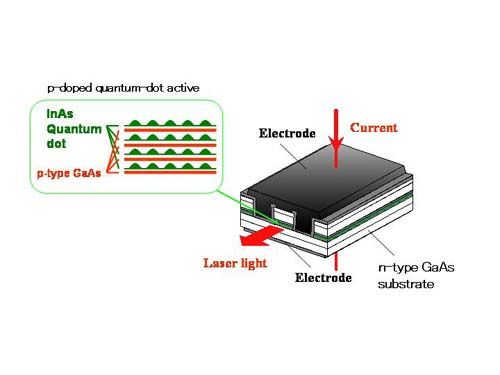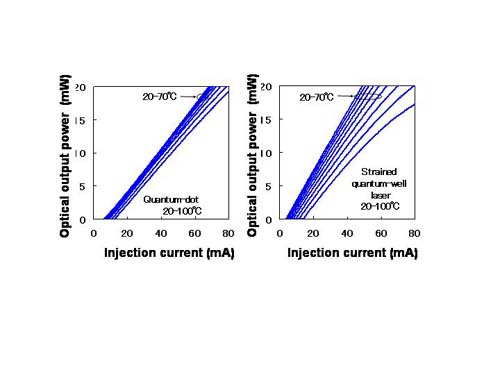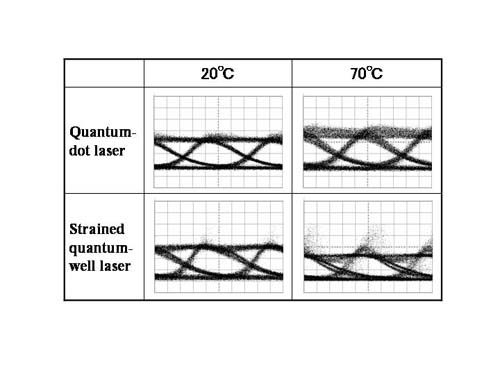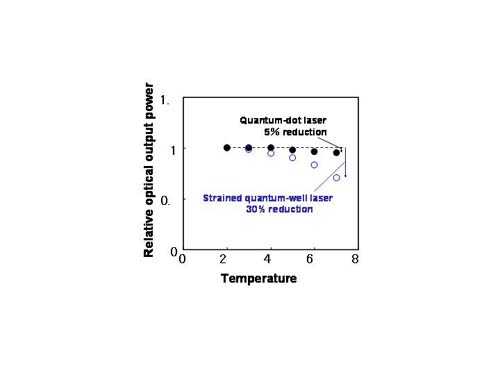Archived content
NOTE: this is an archived page and the content is likely to be out of date.
Fujitsu, University of Tokyo Develop World's First 10Gbps Quantum Dot Laser Featuring Breakthrough Temperature-Independent Output
Stable power verified for 20°C to 70°C temperature range without current adjustments
University of Tokyo,Fujitsu Limited
-
[1] quantum dot
Quantum dots are nano-size semiconductors which have completely quantized energy states, thereby enabling the realization of semiconductor lasers featuring extremely high efficiency. Research and development efforts are actively underway to use indium arsenite (IdAs) quantum dots as optical transmitters in photonic networks. Quantum dot lasers, which incorporate the use of quantum dots in the active light-emitting area region of semiconductor lasers, were proposed in 1982 by Professor Arakawa and Professor Sakaki of the University of Tokyo [Y. Arakawa and H. Sakaki: Appl. Phys. Lett., 40, 939 (1982)].
-
[2] optical metro-access systems
Optical transmission system using optical fibers within cities to enable user access. Optical transmission systems were initially used as long-distance telecommunication systems to connect large cities. The development of broadband transmission is now accelerating the spread of optical fibers to both homes and offices.
-
[3] high-speed optical LAN
Local Area Network (LAN) between computerized instruments for high-bit-rate data transmission. Currently, 10Gbps LAN is standardized.
-
[4] Fujitsu, University of Tokyo Develop World's First 10Gbps Quantum Dot Laser Featuring Breakthrough Temperature-Independent Output
Optical intensity ratio of the "1" level against the "0" level used to describe the modulation characteristics of lasers. In present optical communications, the high optical intensity is assigned to the "1" level and the low intensity to "0". A large extinction ratio is desirable for accurate discrimination of digital data.
About Fujitsu
Fujitsu is a leading provider of customer-focused IT and communications solutions for the global marketplace. Pace-setting technologies, highly reliable computing and communications platforms, and a worldwide corps of systems and services experts uniquely position Fujitsu to deliver comprehensive solutions that open up infinite possibilities for its customers' success. Headquartered in Tokyo, Fujitsu Limited (TSE: 6702) reported consolidated revenues of 4.7 trillion yen (US$45 billion) for the fiscal year ended March 31, 2004.
For more information, please see: http://www.fujitsu.com/
Technical Contacts
Professor Yasuhiko ArakawaDirector of Nanoelectronics Collaborative Research Center
Research Center for Advanced Science and Technology
Institute of Industrial Science
![]() Phone: +81-3-5452-6245
Phone: +81-3-5452-6245
Company:University of Tokyo
Technical Contacts
LSI GroupDevice Development Division
![]() Phone: +81-46-250-8252
Phone: +81-46-250-8252
![]() E-mail: qdot@ml.labs.fujitsu.com
E-mail: qdot@ml.labs.fujitsu.com
Company:Fujitsu Limited
Details are current on the day of issue of the press release and may be subject to change thereafter without prior notice.
Date: 10 September, 2004
City: Tokyo
Company:
University of Tokyo,
Fujitsu Limited,
,
,
,



